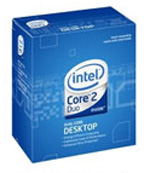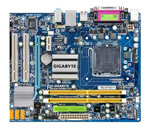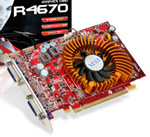Intel Budget
In the past, Intel offerings have tended to be more expensive than configurations from AMD, but our Intel and AMD budget PCs carry virtually identical prices. With prices the same, you can choose your budget system based on other features that are important to you.
| Intel Budget PC | ||
| Hardware | Component | Price |
| Processor | Intel Core 2 Duo E7500 Wolfdale (Dual-core 2.93GHz, 45nm, 65W, 3MB Shared L2, 1066FSB) |
$140 |
| Cooling | CPU Retail HSF | - |
| Video | Sapphire Radeon HD 4770 512MB 100277L | $100 |
| Motherboard | Gigabyte GA-G41M-ES2L Intel G41 Micro ATX | $65 |
| Memory | OCZ Platinum Model OCZ2P10664GK 2x2GB 5-5-5 DDR2-1066 ($63 less $25 Rebate) |
$38 |
| Hard Drive | WD Caviar Green WD6400AACS 640GB 16MB Cache | $65 |
| Optical Drive | Sony Optiarc Model AD-7240S-OB 24X DVDRW SATA | $24 |
| Audio | On-Board | - |
| Case | Cooler Master Elite 330 RC-330-KKN1-GP Mid Tower | $40 |
| Power Supply | BFG Tech LS Series LS-550 550W SLI/CrossFire Ready 80 Plus Certified ($80 less $20 Rebate) |
$60 |
| Base System Total | $532 | |
| Display | ASUS VH222H 21.5" 5ms Widescreen 16:9 LCD (1920x1080) | $155 |
| Speakers | Cyber Acoustics CA3090WB 2.1 Gaming Speakers | $16 |
| Input | Microsoft CA9-00001 PS/2 Keyboard and Optical Mouse | $17 |
| Operating System | Microsoft Vista Home Premium SP1 (for System Builders) | $99 |
| Complete System Bottom Line | $819 | |
 |
The E7500 ups the bus to 1066 from the 800FSB of our entry-level Intel system. A dual-core 2.93GHz with 3MB of cache won't be a slouch in any department in your budget system. Yes the new Core i7 is faster, but it is also much more expensive. The question for a budget system is how good the performance is for the money spent. The E7500 SYSmark 2007 score is about 72% of the top Core i7 965 Extreme. That is fantastic performance for a CPU that costs just $140. The E7500 is also a candidate for overclocking if you are inclined to move the performance a bit closer toward the 3.33GHz Core 2 Duo E8600, which reaches 88% of the i7 965 SYSmark performance. The only drawback to this processor choice is the lack of Intel's Virtualization Technology (Intel VT). If running the Windows Virtual PC under Windows 7 for XP Mode (as one example) is important to you, then moving up to the E8x00 range is the only valid option near this price point.
 |
Unfortunately, we do not have any motherboards in the Intel budget sector that offer the price to performance ratio of our AMD choice. However, we did find a board that would suit most of our needs and it also comes from Gigabyte. The GA-G41M-ES2L motherboard offers a very solid platform for our processor and discrete ATI 4770 video card choices. It could also double as a barebones entry-level contender. This board features the Intel G41 Northbridge and ICH7 Southbridge along with support for 8GB of memory. Gigabyte tosses in the Realtek ALC 888B HD audio codec, Realtek RTL8111DL Gigabit LAN controller, eight USB 2.0 ports, one IDE connector, and four SATA 3Gb/s connectors. The board uses the uATX form factor, and while uATX boards are often a layout nightmare the Gigabyte layout is very good for most applications.
Designed for the casual overclocker in mind, the BIOS allows for decent headroom with FSB speeds hitting 333MHz on our E5200 and E7400 processors. The board has been extremely stable in testing so far and we recommend it. Our only drawback is the small number of SATA ports and the missing support for AHCI/NCQ due to the use of ICH7. In order to get the ICH10 Southbridge, you will have to step up to the G43/P43/P45 offerings that run an additional $15~$30 more for performance-oriented motherboards. That will be a small price for many users, but when every penny counts it can certainly matter.
We did not select an aftermarket CPU heatsink for either budget system to go along with our CPU choices. For this budget, a $50 solution from Thermalright or Scythe is simply not a realistic option, and the stock AMD and Intel heatsinks are good for decent if unspectacular overclocks of the E7500 and Phenom II 720BE. However, if you want spectacular overclocking, both CPUs benefit from better cooling and you can take either CPU to Mt. Olympus heights by adding a better CPU heatsink/fan. You'll just have to decide if the $50 spent on a separate cooler and higher CPU overclocks are better than a larger HDD, faster GPU, better LCD, or more RAM.
 |
Again, we have discussed the option of discrete video cards for our budget systems in past guides. However, it was always an option that would drive up the cost of the system by $150 or so. We just could not recommend an inexpensive budget based card like the ATI HD 4550 as the price to performance benefits over the integrated solutions were just not there. Our opinions changed with the release of the ATI HD 4770 card last month. We did our best to figure out a way to shoe horn in this remarkable "budget" card to create a system that allows midrange gaming performance in most game titles, excellent HTPC capabilities, HD video playback, and crystal clear Aero performance at high resolutions in Windows 7 or Vista. Yes, not everyone in this market sector needs this "luxury" option. We are selecting the ATI Radeon HD 4770 as our jack-of-all-trades GPU for our budget configurations. If you want less performance for a lower cost, the MSI HD 4670 is a reasonable alternative at just $53 after rebate.
The rest of the components are the same as those found in the AMD budget system. Sound cards at this budget are simply an unnecessary luxury, and the onboard offerings continue to improve with each new motherboard generation. You can be reasonably happy with the onboard sound until you figure out if you want to upgrade to something better.










65 Comments
View All Comments
Wesley Fink - Thursday, May 14, 2009 - link
That is the way it is on the Intel side. We have to go up to the $169+ range to get VT on Intel and quite frankly, maybe 1% of people might ever run XP mode in Win7.If running the Windows Virtual PC under Windows 7 for XP Mode is important to you, then moving to the E8x00 range or the E6x00 are the best VT options. That would blow the Budget out the door, and make the Intel selections not competitive in the Budget Range.
Do you work for AMD? This is a really minor nag for the vast majority of our readers, and as I'm sure you aware, for a Budget PC if this feature really matters to you then go for an AMD system in the budget price range.
nycromes - Thursday, May 14, 2009 - link
I think their point was/is that there is no mention of it in the article. It is nice to know what you get and what you don't get for these kind of systems. I don't think many will need the VT feature, but it could have still been presented in the article for those that might need it. I wouldn't change the recommendations, but just a small blurb about it would probably suffice.Of course, if they read the comments, there is plenty of mention of it so it doesn't really matter anymore.
Gary Key - Thursday, May 14, 2009 - link
We had strict budget numbers to meet for this guide. We had to select the entry level Intel processors due to cost and still provide a decent set of components around it. We added a statement about VT support to the processor descriptions.HelToupee - Thursday, May 14, 2009 - link
This will be a boon to those using non-Microsoft OSes for our HTPC's XBMC, my HTPC OS of choice has supported nVidia's accelerated video playback for quite awhile now. Unfortunately, players have not been able to take advantage of AMD/ATI's Linux drivers due to AMD/ATI being slow to release specs/headers. Acelleration on nVidia is supported in most major Linux video players by default, all you have to do is have the nVidia binary driver installed.kleinwl - Thursday, May 14, 2009 - link
It's probably worth mentioning that a core i7 makes a great cpu in an HTPC. While it blows the budget, if you are looking to upscale DVDs using ffdshow (or the like) to fit your 52" screen, I would suggest that you do not skimp on the cpu power. While ffdshow is a nightmare to get properly configured (thousands of options, no consistent recommendations), once you do, you can have a viewing experience close to that of an oppo. However, ffdshow can be a resource hog, and thus I recommend pushing the cpu spec as high as you can aford.Spoelie - Friday, May 15, 2009 - link
1. Size of the screen is not directly related to resolution (and thus scaling power needed). There are large plasma screens with the same resolution as a 17" LCD. A modern 52" TV will 'only' have a resolution of 1920x1080, and as such BR will need no scaling, and decoding DVDs is such a light load that there's plenty left for upscaling.There's a reason media tanks do not use super-fast general purpose cpus. They just aren't needed for playing back stuff, even with scaling.
The only valid reason to push cpu power is for transcoding.
2. Ideal = low power, noise, heat, consumption. Not something one would associate with an i7.
Nowadays, even though I have a HTPC, I'm of the opinion you're better of with a media server/transcoder somewhere in a back room and a networked media tank next to the screen instead of a single device to do both tasks.
HOOfan 1 - Thursday, May 14, 2009 - link
Just an FYInecrohippy - Thursday, May 14, 2009 - link
biostar t-series motherboard amd athlon x2 3.0ghz 4gb ram 500watt moduler psu decent case nvidia gtx geforce 260 896mb video card xp pro $600 after rebate $750 in the first place changed cpu from 3ghz to 4.5ghz a great gaming rig for the money....smoken. I had keyboard,mouse,and 19inch viewsonicmrubermonkey - Thursday, May 14, 2009 - link
With these Intel systems people will not be able to do hardware virtualization of Windows XP from within Windows 7, but people with AMD systems should be alright.JarredWalton - Thursday, May 14, 2009 - link
I think you're talking about a very small group of people that will even need that feature. Virtual XP is a "fix" from MS that's only for older programs that refuse to work right with Win7, and even then you're running with the equivalent of old unaccelerated GPUs. If you have a program that works with Vista, it should be fine on Win7. If you need virtualization that badly, though, by all means make sure you buy a CPU that supports hardware VT. (Intel will be releasing updated versions of many CPUs with VT enabled in the near future.)